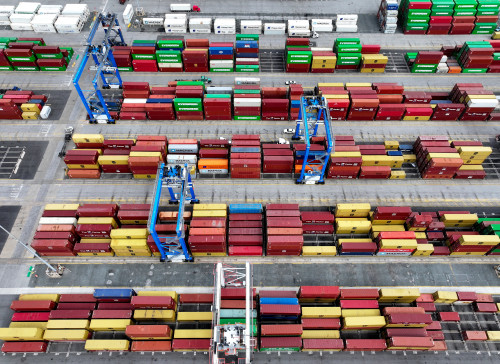By Howard Schneider
WASHINGTON (Reuters) – New import taxes imposed or potentially in the offing from the Trump administration could raise the average effective tariff rate on goods coming into the U.S. from the current 2.2% to around 17%, while posing “widespread disruptions” focused on manufacturing industries in Midwestern and Southern states, a new analysis from the Richmond Federal Reserve has concluded.
Some working estimates of the result of tariffs President Trump imposed in 2018 and 2019 were a net loss of jobs and output to the U.S. economy, the authors noted, with the current more aggressive set of tariffs risking damage also.
Ad Priority Gold_SS
The DOJ just argued in court that your cash isn't legally your property. That means they can take it whenever they want. History proves that when governments go broke, they take from the people. Smart investors aren't waiting. Get your FREE Wealth Protection Kit now and discover how to shield your wealth before the next financial crackdown!
Claim your FREE Wealth Protection Kit – protect your assets before it's too late!
“Ultimately, the proposed tariffs may raise input costs, disrupt supply chains and result in higher consumer prices, potentially outweighing any targeted employment gains in protected industries,” Richmond Fed economists including bank vice president Sonya Waddell and senior economist Marina Azzimonti wrote.
“Policymakers should carefully weigh these costs against intended policy goals and consider targeted measures to support the industries and communities most adversely impacted by these tariff changes.”
The analysis, published just hours before Trump is to announce potentially sweeping new import levies, looked at import shares by industry across U.S. counties, and estimated what a range of different import tax scenarios would mean in practice – some including steps already taken by Trump, like a 25% tax on autos and steeper levies on goods from China, and some that could be put in place later on Wednesday like taxes on Mexico and Canada.
Average tariffs reach their peak under the most aggressive scenario, which includes a 25% tax on imports from the European Union.
Trump is due to make an announcement at 4 p.m. EDT (2000 GMT) about how much of a levy he wants to impose on which countries.
“The 2025 tariff proposals represent significant shifts in U.S. trade policy, with potentially large economic impacts varying across industries and regions,” the analysts wrote. Earlier tariffs focused on China, they noted, had only “muted” impacts as global supply chains adjusted.
The new measures, however, “targeting Canada, Mexico, the EU and automobiles threaten widespread disruptions across key U.S. industries.”
The authors caution their analysis is static and does not account for the full scope of tariff impacts, from changes in consumer demand as prices shift to changes in investment patterns or supply chains that could lead to more domestic production.
But “adjustments take time,” they wrote, while the immediate impact would fall particularly hard on auto and metal-intensive industries, and on states including Michigan, Ohio, Indiana, and the Southeast. When levies are applied to the EU the impact changes “from a mostly regional issue to a national economic concern.”
(Reporting by Howard Schneider; Editing by Andrea Ricci)












